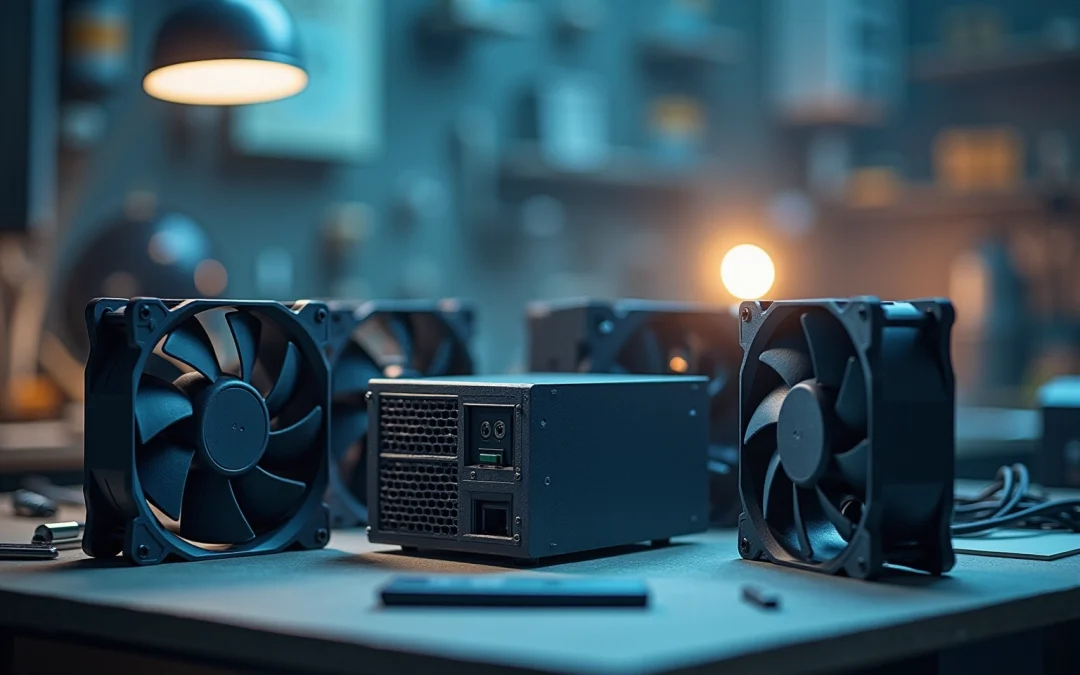Overview
This article provides a comprehensive comparison of small fans designed for cooling electronics, focusing on essential features and notable brands. It emphasizes the critical importance of selecting the right type of fan—be it axial, centrifugal, or blower—tailored to specific cooling requirements. Leading brands such as Noctua, Delta Electronics, and Sunon are discussed for their reliable and efficient solutions, catering to a diverse range of applications. By understanding these factors, readers can make informed decisions that enhance their electronic cooling strategies.
Introduction
Temperature control is a critical yet often overlooked aspect of electronic device performance; improper cooling can lead to inefficiencies and potential failures. This article delves into the world of small cooling fans, exploring their essential role in maintaining optimal operating temperatures across various electronic applications. As technology advances, the challenge remains: how can one choose the right fan type and brand to ensure reliable thermal management?
By examining the features and benefits of different fan types, alongside a comparative analysis of leading brands, readers will gain valuable insights that empower them to make informed decisions when selecting the best cooling solutions for their electronics.
Understanding the Role of Cooling in Electronics
Temperature regulation is crucial for the performance and reliability of electronic devices. Gagner-Toomey Associates distinguishes itself as the world’s largest manufacturer of both standard and custom air-movers designed for temperature control applications across a multitude of sectors, including:
- Automotive/Transportation
- Telecom/IT
- Energy
As electronic components generate heat during operation, a small fan for cooling electronics is essential to dissipate this heat and maintain optimal operating temperatures. Every piece of IT equipment that consumes power generates an equivalent amount of heat, underscoring the necessity for efficient thermal management solutions. Overheating can lead to diminished efficiency, component failure, and catastrophic events such as fires, significantly reducing the lifespan of devices.
Gagner-Toomey offers an extensive range of DC input tube axial units, varying from 15 to 280mm, as well as centrifugal blowers ranging from 15 to 225mm, all optimized for performance, efficiency, and low noise, ensuring that devices remain within safe temperature limits. Compact blowers find frequent application in a variety of uses, from consumer devices to industrial equipment. Understanding the of specific applications is vital for selecting the appropriate temperature control solution, making this foundational knowledge essential for any comparative assessment of a small fan for cooling electronics.
Furthermore, thermal interface materials (TIMs) are critical in facilitating effective heat transfer between components and heat sinks, thereby enhancing thermal management. Gagner-Toomey’s integrated temperature control solutions, which include precision in-row temperature units and air economizers, have demonstrated their effectiveness in boosting efficiency within data centers, ultimately leading to reduced energy consumption and operational costs.
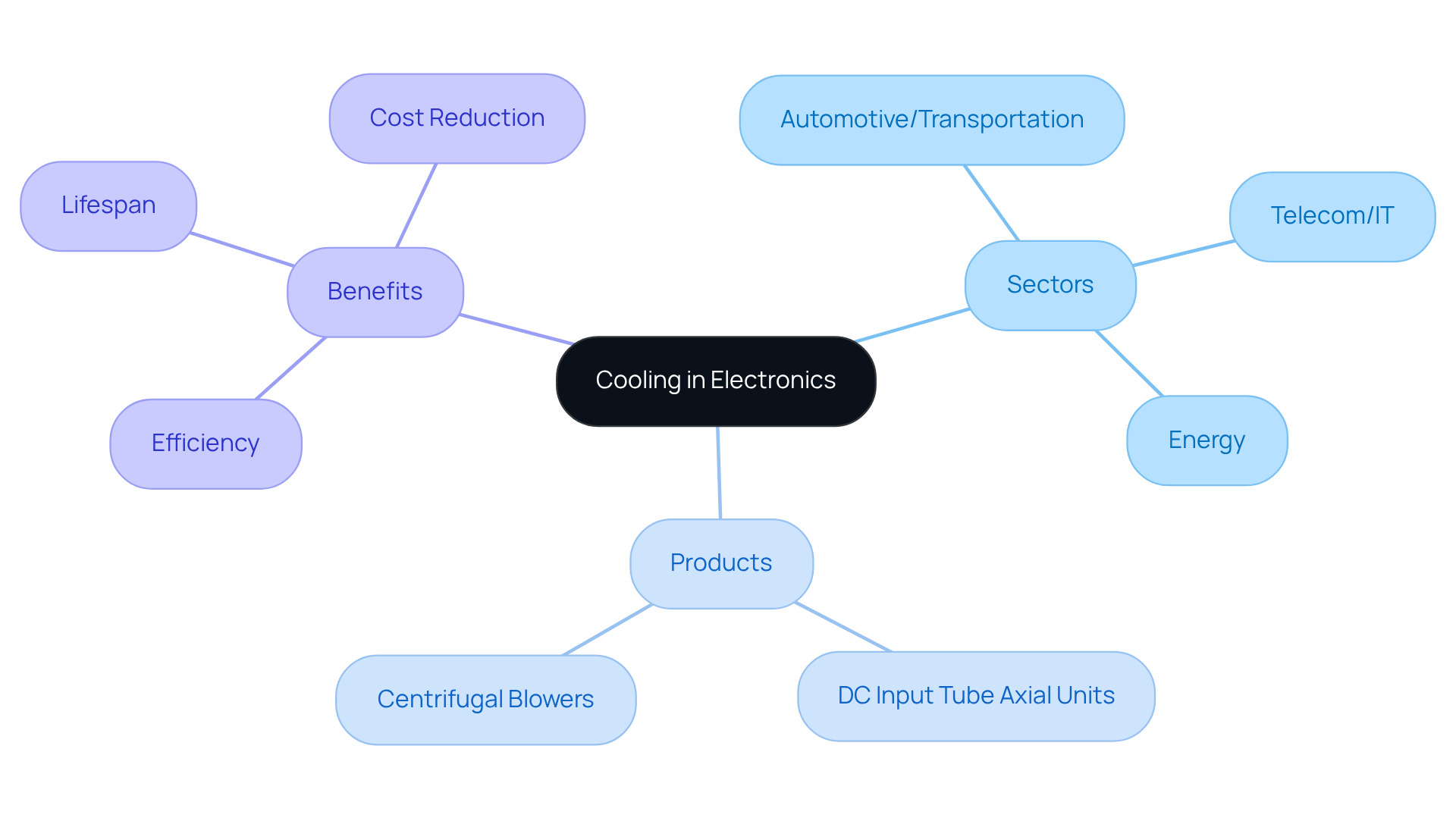
Exploring Different Types of Small Cooling Fans
Small cooling fans are essential components in various electronic applications, categorized primarily into three types, each tailored for specific cooling needs:
- Axial Fans: These fans operate by moving air parallel to their axis, making them highly efficient and compact. They are particularly effective for cooling enclosures and electronic components, where a small fan for cooling electronics is especially beneficial due to limited space. Their design permits a high volume of air movement, which is essential in preventing overheating in devices like power supply units and servers.
- [Centrifugal Blowers](https://gagner-toomey.com/10-key-insights-on-axial-vs-centrifugal-fan-performance): Also referred to as blower units, these devices draw air in through the center and expel it at a right angle. This design allows them to produce greater pressure and air movement, rendering them appropriate for uses that demand strong temperature regulation solutions. Centrifugal blowers are frequently utilized in HVAC systems and industrial equipment, where efficient air circulation is essential.
- Blower Fans: A particular category of centrifugal fans, blower fans deliver a focused stream of air, perfect for confined areas that need directed temperature regulation. Their capacity to direct airflow makes a small fan for cooling electronics especially beneficial in contexts like regulating temperatures of electronic parts in compact devices.
Comprehending the distinctions among these fan types is essential for choosing the appropriate temperature control solution. For example, axial blowers are typically favored for their efficiency in low-pressure settings, while centrifugal units perform exceptionally well in high-pressure scenarios. Performance comparisons suggest that axial units generally deliver greater air movement rates, while centrifugal models present enhanced pressure capabilities, rendering them appropriate for various electronic thermal management situations.
In practical uses, axial blowers are frequently utilized in consumer electronics, automotive systems, and data centers, where effective temperature management is essential. In contrast, centrifugal blowers are frequently located in larger industrial environments, where they regulate airflow in intricate systems. This distinction underscores the importance of selecting the suitable fan type according to .
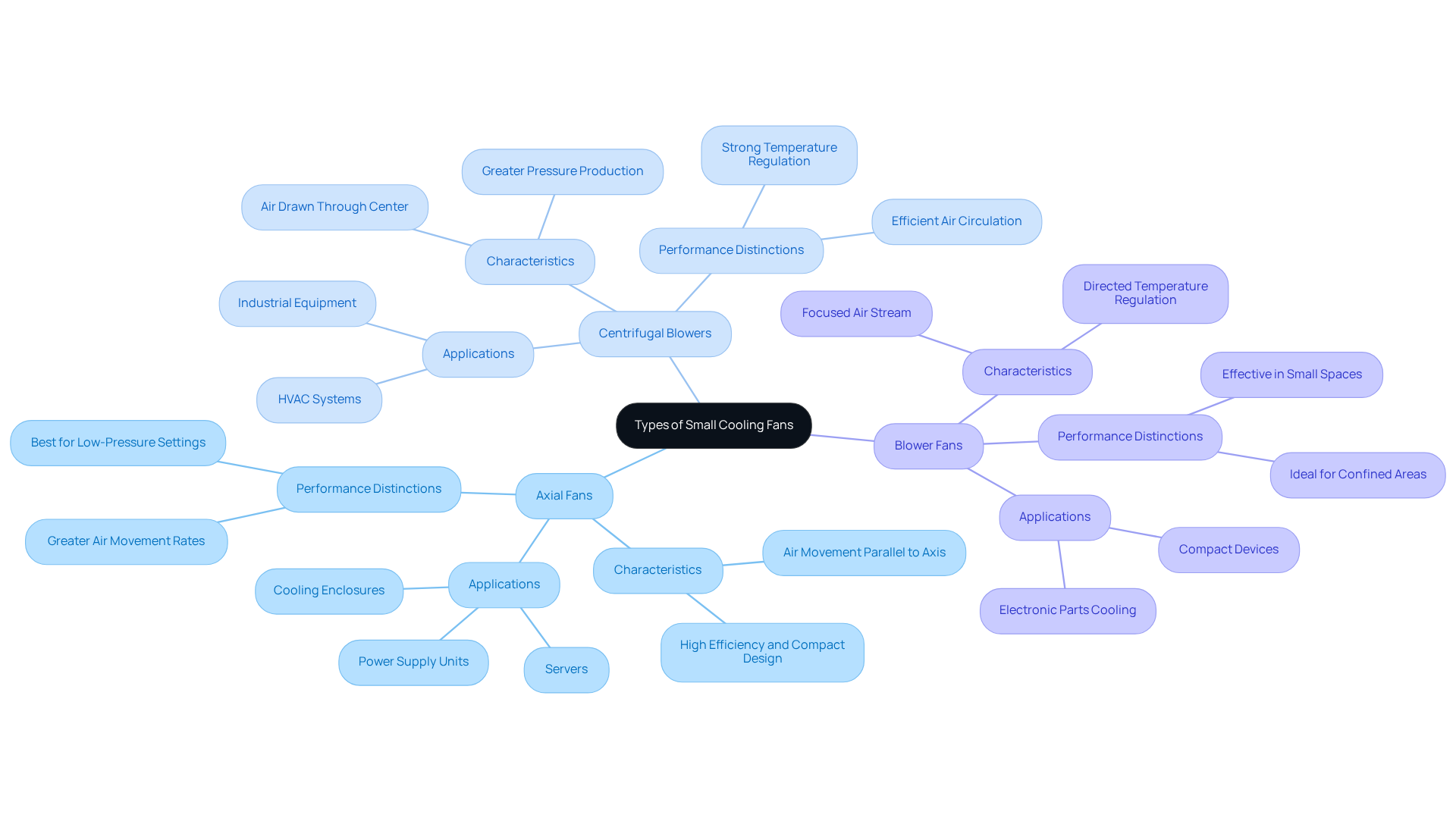
Comparative Analysis of Top Small Fan Brands and Models
In the competitive landscape of small air circulators, several brands distinguish themselves through their unwavering commitment to quality and performance. This comparative analysis delves into notable brands and their standout models:
- Noctua: Esteemed for their high-performance axial fans, Noctua products are celebrated for their low noise levels and exceptional airflow. The NF-A4x10 FLX model, for instance, is particularly well-suited for compact spaces, offering effective temperature regulation while maintaining a quiet operation. Users have reported that Noctua models can function flawlessly for five to ten years, underscoring their reliability. Furthermore, the NV-FS1 model has garnered praise for its engineering quality and versatility, supported by a six-year warranty, positioning it as a formidable contender in the market.
- Delta Electronics: As a frontrunner in temperature regulation solutions, Delta presents a diverse range of centrifugal devices recognized for their robust airflow and pressure capabilities. The AFB0412HH model is especially favored in industrial settings, where its performance is crucial for sustaining optimal operating conditions. Delta’s commitment to innovation ensures that their products meet the rigorous demands of various applications. Case studies have illustrated that Delta units effectively maintain cooling in high-stakes environments, further solidifying their reputation.
- Sunon: Sunon products are recognized for their reliability and energy efficiency. Utilizing MagLev technology in models such as the MF40101V1-1000U-A99, these devices , making them ideal for sensitive electronic environments. This technology not only boosts performance but also contributes to quieter operations, making it ideal for applications that may require a small fan for cooling electronics. Customer satisfaction ratings indicate that Sunon products are well-regarded for their performance and durability.
This analysis underscores the strengths of each brand, enabling readers to make informed decisions based on their specific temperature requirements and preferences.
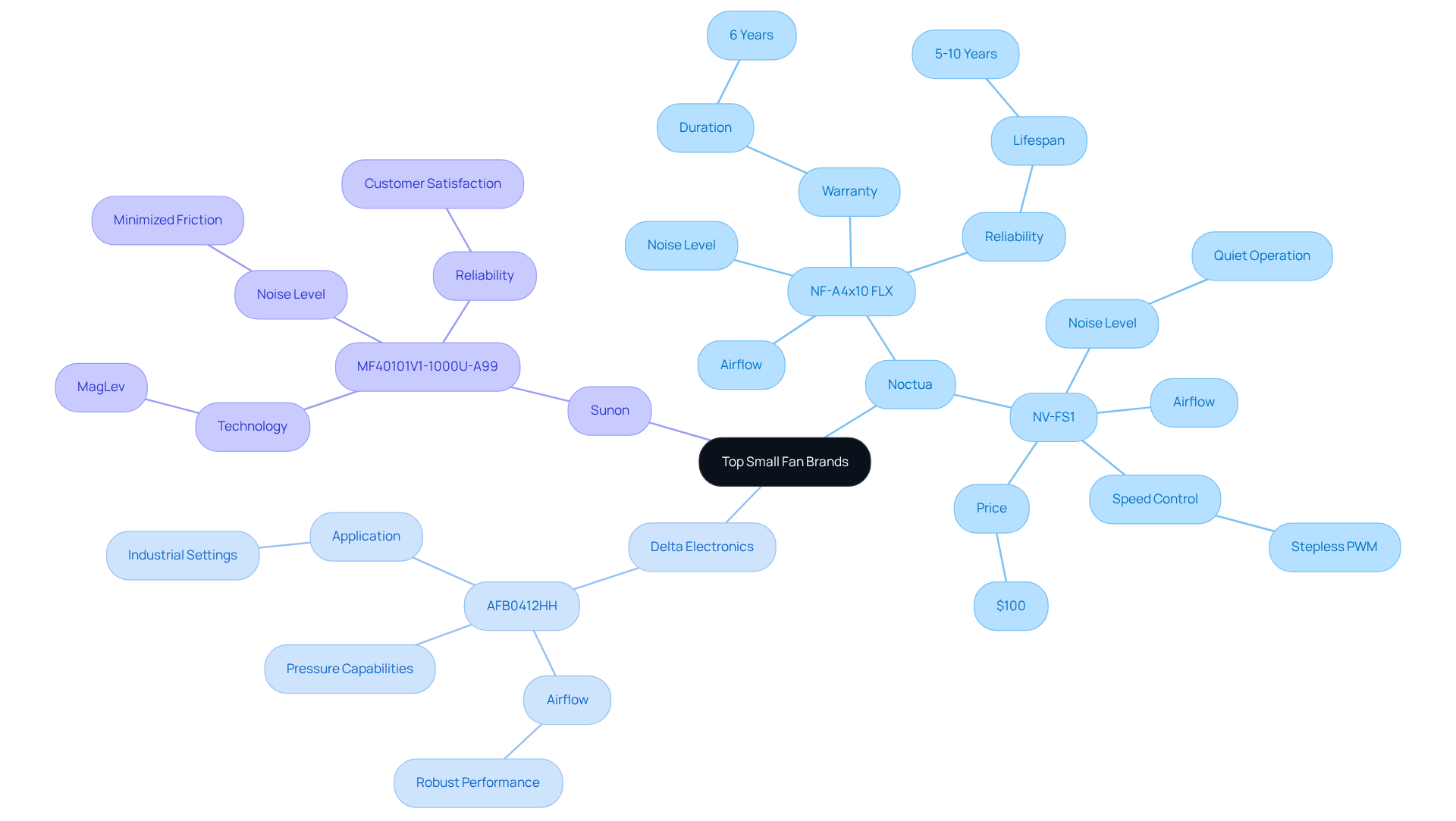
Evaluating Key Factors for Selecting Small Cooling Fans
When selecting small cooling fans, several key factors must be considered to ensure optimal performance:
- Airflow and Pressure: Understanding the required airflow, measured in cubic feet per minute (CFM), and static pressure is crucial for effective cooling. Various applications may necessitate differing airflow characteristics. For instance, static pressure devices maintain CPU temperatures 3 degrees Celsius lower than ventilation systems in radiator setups, emphasizing the importance of selecting the appropriate type according to specific cooling requirements. The static pressure rating of the Delta Electronics AFB0412HH fan is 0.359 inchH2O, which is essential for assessing its performance in high-resistance environments.
- Noise Levels: Noise can be a significant concern in consumer electronics. Fans with lower decibel ratings are preferable in environments where quiet operation is paramount. The Noctua NF-A6x25 FLX fan, for example, operates at a mere 19.2 dB(A) and achieves a peak speed of 3,000 RPM, making it an excellent choice for noise-sensitive applications. Additionally, static pressure devices operate more quietly under load due to their design, which minimizes turbulence.
- Size and Form Factor: The physical dimensions of the fan must fit within the designated space in the electronic device. Compact designs are often necessary for smaller devices, such as the Delta Electronics AFB0412HH fan, which measures 40x40x15mm, rendering it suitable for tight spaces.
- Power Consumption: Energy efficiency is increasingly important. Selecting devices that provide adequate temperature regulation while consuming less energy can enhance overall system efficiency. A 10% decrease in RPM can result in a 27% reduction in brake horsepower, underscoring the need for efficient fan operation. The projected CAGR for the market of small fans for cooling electronics is approximately 2.9%, highlighting the growing significance of efficient temperature regulation solutions within the electronics industry.
- Durability and Reliability: Fans should be rated for extended operational lifespans, particularly in critical applications. Features such as ball bearings or advanced technologies enhance longevity, ensuring that the fan can endure the demands of continuous operation.
By evaluating these factors, engineers can make informed decisions that align with their specific cooling needs, ultimately enhancing the performance and reliability of electronic systems.
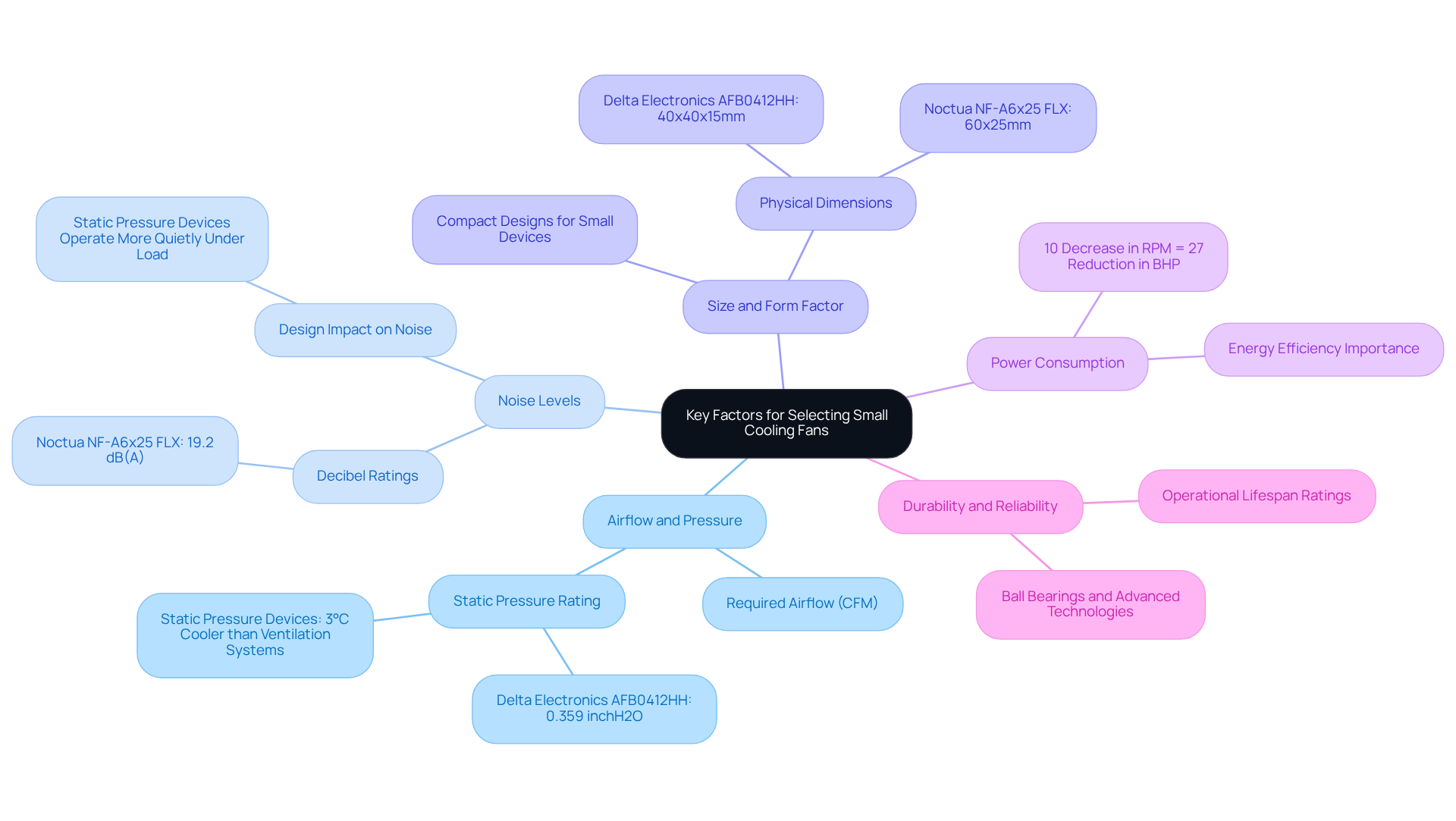
Conclusion
Temperature management is crucial for the efficiency and longevity of electronic devices, making the selection of the right small cooling fan vital. By understanding the various types of fans—axial fans, centrifugal blowers, and blower fans—stakeholders can make informed choices tailored to specific cooling requirements. Each fan type presents unique advantages:
- Axial fans excel in compact spaces.
- Centrifugal blowers deliver robust airflow in demanding environments.
A comparative analysis of leading brands such as Noctua, Delta Electronics, and Sunon reveals the strengths and innovations each contributes to the market.
- Noctua is renowned for its low noise and high performance.
- Delta is recognized for its robust airflow capabilities.
- Sunon stands out with its energy-efficient designs.
When selecting a small cooling fan, it is essential to evaluate key factors such as airflow, noise levels, size, power consumption, and durability, ensuring the chosen solution aligns with the specific needs of the application.
Ultimately, effective thermal management transcends mere overheating prevention; it enhances the overall performance and reliability of electronic systems. As technology advances, the significance of selecting the optimal small fans for cooling electronics remains paramount. By prioritizing the right features and comprehending the implications of cooling on device performance, stakeholders can make strategic decisions that lead to improved operational efficiency and device longevity.
Frequently Asked Questions
Why is temperature regulation important for electronic devices?
Temperature regulation is crucial for the performance and reliability of electronic devices because overheating can lead to diminished efficiency, component failure, and catastrophic events such as fires, significantly reducing the lifespan of devices.
What types of sectors does Gagner-Toomey Associates serve with its cooling solutions?
Gagner-Toomey Associates serves multiple sectors, including Automotive/Transportation, Telecom/IT, and Energy, with their cooling solutions.
What types of cooling products does Gagner-Toomey offer?
Gagner-Toomey offers an extensive range of DC input tube axial units, varying from 15 to 280mm, as well as centrifugal blowers ranging from 15 to 225mm, all optimized for performance, efficiency, and low noise.
What are thermal interface materials (TIMs) and why are they important?
Thermal interface materials (TIMs) are critical in facilitating effective heat transfer between components and heat sinks, thereby enhancing thermal management in electronic devices.
How do Gagner-Toomey’s integrated temperature control solutions benefit data centers?
Gagner-Toomey’s integrated temperature control solutions, including precision in-row temperature units and air economizers, have demonstrated effectiveness in boosting efficiency within data centers, leading to reduced energy consumption and operational costs.
What is the role of small fans in cooling electronics?
Small fans are essential for dissipating heat generated by electronic components during operation, helping to maintain optimal operating temperatures and ensuring the longevity and efficiency of IT equipment.

